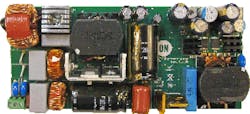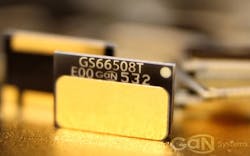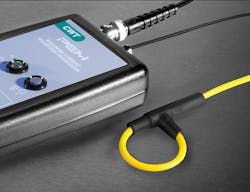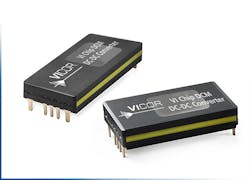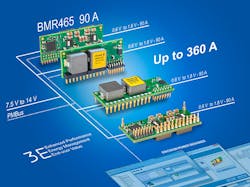After the past couple of months, the term “blizzard” may trigger some post-traumatic shivers. However, engineers can quickly warm to the torrent of product announcements made at this year’s IEEE Applied Power Technology Conference, which opened Monday, March 16, in Charlotte, N.C. Here are five that I found particularly interesting:
ON/Transphorm Team Presents Cascode Transistors
ON Semiconductor and Transphorm jointly introduced 600-V GaN cascode transistors along with a 240-W reference design that utilizes the devices. If you’re curious about what the cascode transistor configuration has to do with power devices, take a look at “Cascode Configured GaN Switch Enables Faster Switching Frequencies And Lower Losses.” It’s not by ON or Transphorm, but it’s the clearest explanation I’ve seen.
The two new transistors’ model numbers are the NTP8G202N (TPH3202PS) and NTP8G206N (TPH3206PS), while the evaluation board is dubbed the NCP1397GANGEVB (TDPS250E2D2). According to the announcement, its boost stage delivers 98 % efficiency at 200+ kHz. Visit ON Semiconductor’s website for full documentation.
GaN Systems’ Novel Cooling Technology
GaN Systems unveiled a new topside cooling technology for its enhancement-mode devices. Topside cooling facilitates the use of printed-circuit-board cooling techniques. The gallium-nitride (GaN) power transistors use the company’s proprietary Island technology, in which the die consist of islands rather than traditional fingers. The company claims it enhances current handling, reduces inductance, and shrinks die size. Current ratings range from 8 to 250 A.
Key to performance is GaN Systems’ unique “GaNPX” packaging technology. Die is embedded within a laminate construction, and a series of galvanic processes replace conventional clips, wire bonds, and molding compounds.
Rogowski Current Probes from PEM
Speaking of measuring transient currents in GaN and silicon-carbide (SiC) semiconductors, Power Electronic Measurements Ltd. (PEM) picked APEC to introduce its CWT MiniHF Rogowski current probe. The device employs a unique shielding technique that uses a low-sensitivity coil and patented low-noise signal-conditioning circuitry. The probes are small, but deliver 3-dB bandwidth up to 30 MHz for a 100-mm coil. The coil itself is only 4.5 mm thick, even while providing 5-kV insulation.Max current slope is 100 kA/µs.
If you’re unfamiliar with Rowgowski coils and how they compare with other current measurements, take a look at the article “Components and Methods for Current Measurement.”
Vicor Cites 93% Efficiency for DC-ZVS “DCM” Converters
The DCM Converter Module series of isolated, regulated dc-dc converters now provide nominal input voltages of 24, 28, 48, 270, 290, and 300 V, with nominal outputs of 48, 36, 28, 24, 15, 12, and 5 V. Power ratings range to 600 W. Target applications include aerospace, EV/HEV, rugged systems, industrial, and telecom/datacom. Vicor’s approach to distributed power is unique (for detailed information, see “Architecting Power Design Success”).
The company says that by using the DC-ZVS topology described in the above article, designers can achieve 93% typical efficiency. On top of that, power density is more than two times better than what’s achievable with conventional dc-dc converters.
Ericsson Presses Forward on PoL Performance
Taking a more conventional approach to distributed power, Ericsson came to APEC with a new two-phase, 90-A, digital point-of-load (PoL) dc-dc power module focused on network processors. The BMR465 offers compensation-free performance and the ability to connect modules in parallel to provide up to 360 A.
These capabilities target future software-defined power architecture (SDPA) systems. Power-system designers foresee such systems as the key to achieving highly efficient and energy-optimized network architectures by 2020.
The BMR465, which complies with PMBus commands, has been integrated into the Ericsson Power Designer software, making it easy for designers to simulate and configure complete multi-module and multiphase systems.
The new PoLs offer “compensation-free” modulation techniques, which provide stability, accurate line and load regulation, and good transient performance. Nonlinear charge-mode control guarantees that the control loop is always stable and load step response occurs within a single switching cycle. As a result, half-load efficiency is 94.3% at 12-V input and 1.8-V output.
About the Author
Don Tuite Blog
Don Tuite covers Analog and Power issues for Electronic Design’s magazine and website. He has a BSEE and an M.S in Technical Communication, and has worked for companies in aerospace, broadcasting, test equipment, semiconductors, publishing, and media relations, focusing on developing insights that link technology, business, and communications. Don is also a ham radio operator (NR7X), private pilot, and motorcycle rider, and he’s not half bad on the 5-string banjo.

